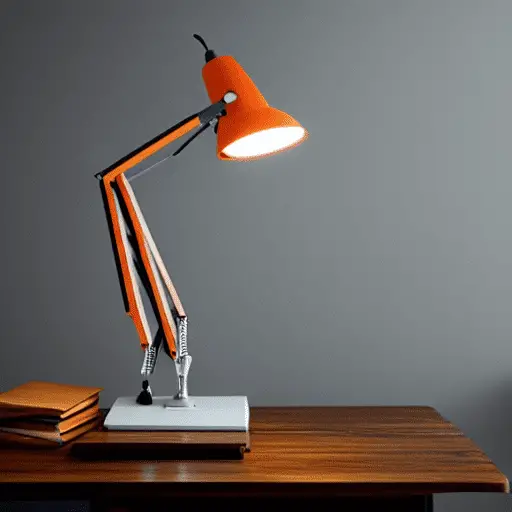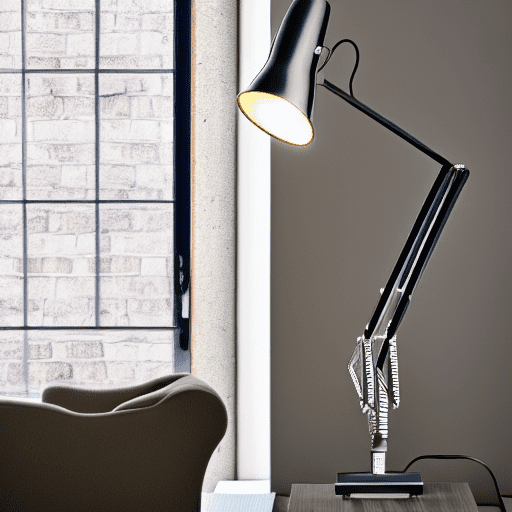Do you know how the anglepoise lamp saves energy?
It’s actually a pretty ingenious design. The lamp has a balancing mechanism that allows it to be adjusted easily, and this mechanism helps to keep the light from being too bright.
Because the light isn’t as bright, less energy is used. So if you’re looking for an eco-friendly way to light up your space, consider using an anglepoise lamp!
Let’s dive into more detail, my energy geek friends!
What is Anglepoise light?

Thank you for reading this post 🙌 - don't forget to take advantage of our New Free Tools: Electricity Cost Calculator and Energy Bill Calculator 👇
Energy Bill Calculator
Our Energy Bill Calculator is designed to help you estimate your electricity costs in the…
Electricity Cost Calculator
Do you want to know how much your electrical appliances are costing you every month?…
The Anglepoise light is a lamp designed by British designer George Carwardine in 1932. Designed to resemble a fish, the lamp is reminiscent of nautical ships. Its distinctive shape makes it a popular light fixture. Today, it’s used in both modern and traditional interiors.
The Anglepoise light is a classic design that has evolved over the years. In the first decade of its creation, it became popular in the United States, where its iconic shape became cultural shorthand for the film studios. This iconic design has survived the test of time, and has even been featured on Penguin books and the London Underground map.
Developed in the 1930s, the Anglepoise lamp is one of the most popular lamps today. The design is a synthesis of modern design and old-world craftsmanship. George Carwardine, a British automotive engineer and suspension systems expert, conceived the Anglepoise lamp in his garden workshop in Bath, England. Its patented design has been used in homes, offices and in commercial settings for over eighty years.
The original Anglepoise lamp was designed by British designer George Carwardine in 1932. The original Anglepoise lamp is now available in pendant-lamp and wall-light forms. Its design has been copied and imitated by many.
Who invented the Anglepoise lamp?

Although the Anglepoise lamp is the most popular light source in the world, it is not without rivals. A 1930s British success story, the Bestlite, was a precursor to the Anglepoise. Its designer, Robert Dudley Best, studied under Walter Gropius at the Bauhaus, Dessau. German modernist Karl Trabert, however, produced a desk lamp in 1930 for Schanzenbach & Co., which featured a domed shade and hinged arm. This new lamp was also widely used by animators.
The Anglepoise lamp is an instantly recognizable design. Today, these lamps can be found in homes, offices, and even hotel rooms. Their distinctive shapes have become a symbol of 20th-century design, and they are often passed down through generations. In addition to their iconic status, the Anglepoise lamp is also available in mini and giant versions, and has even appeared in collaborations with famous designers like Paul Smith and Margaret Howell.
While the first Anglepoise lamp was called the “Ellipoise lamp”, it was actually the second-ever Anglepoise. The first model, the 1227, used three springs, a tiered base, and a broader shade. The second, the original Anglepoise, was produced by Herbert Terry & Sons in Bath. In 1932, the first Anglepoise lamp was marketed to the public. Its name changed from Ellipoise to Anglepoise because it was more popular.
The Anglepoise lamp is a popular and iconic lamp that has been a home staple for almost 90 years. Its unique design has been undergoing some evolution, but its core features remain unchanged. It was designed by George Carwardine, an automotive engineer whose specialty was vehicle suspension systems. After Carwardine’s initial prototype was perfected, Herbert Terry & Sons licensed his design and the Anglepoise lamp began to be mass produced.
How does the Anglepoise save energy?

The Anglepoise lamp was created by an automotive engineer named George Carwardine. He was working on suspension systems for vehicles and developed a new type of pre-tensioned spring that could be used in an articulated lamp. He patented this spring design in 1932. He then redesigned the lamp so that the spring could pivot and focus the beam of light in a particular direction without glare.
The Anglepoise lamp was originally developed for close attention applications. In fact, the BBC forbid its workers from working under one without the main light. In 1947, the BBC banned the use of the lamp, fearing it would encourage secrecy and degenerate programming. Later, the Anglepoise lamp was immortalized in a punk rock song, “I Want an Anglepoise Lamp!”
The Anglepoise lamp has an endless history and many uses. Artists, writers, professors, and salespeople use it to illuminate their workspaces. Since it was first introduced in the 1930s, the Anglepoise lamp has come a long way. In today’s market, there are several versions of this lamp, including the Type 75 floor lamp, which has a sturdy base, which is convenient for desk space.
The original Anglepoise lamp had three springs near its base, which kept it in place even if it was moved around. Since its invention, it has been copied and re-imagined by many other manufacturers. The design of this lamp has been so revolutionary, that several companies have adapted it and made it more efficient.
Why was the Anglepoise lamp so successful?

The Anglepoise lamp was created by George Cardwardine in 1932. Unlike other lamps, it used a constant spring mechanism to adjust the light’s direction. Originally designed for industrial settings, it was later developed into the Model 1227, which used three springs.
The anglepoise lamp’s story began when Carwardine, a British automotive engineer, came up with a unique mechanism that enabled the lamp to pivot. This spring-and-lever mechanism enabled the light to stay in the right position at any time – even when the lamp is turned on and off. As demand for this new lamp increased, the company Herbert Terry & Sons licensed the Anglepoise design and started mass production.
From the start, the Anglepoise lamp faced many competitors. One of its biggest competitors was the 1930 Bestlite, a British success story, which was influenced by the Bauhaus movement. Best had studied under Walter Gropius at the Bauhaus in Dessau. A second rival, designed by German modernist Karl Trabert, was the Schanzenbach & Co. desk lamp. Both of these designs had a hinged arm and a domed shade. They are still in wide use today.
Today, the Anglepoise lamp is available in a variety of styles, from small mini versions to larger, oversized lamps. Whether you want to brighten a workspace, create a focal point, or illuminate a landscape, the Anglepoise Type Range will bring a modern twist to your lighting design.
Are Anglepoise lamps worth it?

The Anglepoise lamp is a versatile floor lamp that provides concentrated light for a variety of tasks. These lamps are made with durable materials and are easy to use. The design is simplistic, which makes them easy to use. They also come in an affordable price range. They were invented by George Carwardine, a British lighting engineer born in 1883.
The Anglepoise lamp has been around for almost ninety years. Its design has remained virtually unchanged since its invention. A spring-based system enables it to be easily adjusted, without the need for clamping. This design is particularly useful for situations where you need a constant light source. Originally, these lamps were used by surgeons in operating theatres and by navigators who required constant readjustment of their lights.
Anglepoise lamps can be very expensive. The most expensive one, the Model 1227, can cost up to $260. However, there are many replicas and refurbished versions that are available. If you’re planning to purchase one, you should remember that you can never be too sure about its quality. Some cheap copies might even come with fake or minor flaws.
There are several types of Anglepoise desk lamps available in the market. The first is the ‘1227’ which has a rugged, industrial look. Its three springs are made of chrome or brass. In addition, the shade is available in brass or rimmed, which gives them an elegant look.
Anglepoise Desk Lamps
One of the most common types of desk lamps is the Anglepoise Desk Lamp. They have a simple design with three or four springs at the base of the light. They also have an on/off switch located on the back of the lamp. The Anglepoise Lamp has been around since the 1930s. The design is a classic example of modernist design.
The Anglepoise lamp was originally designed to save energy. It was based on a spring design that could be adjusted to the desired angle and would stay in position. This unique design was originally designed for industrial assembly workers but is also suitable for desk work. In 1932, a man named George Carwardine patented a new spring that was able to be positioned by a single spring in different directions.
The Anglepoise Lamp is an iconic design that has been in circulation for 75 years. Despite its age, its innovative features and endless uses make it an invaluable addition to any workspace. It is widely used by writers, artists, students, professors, salespeople, and businessmen. It has come a long way from the earliest versions of the Anglepoise Lamp, which first hit the market in the 1930s. The modern-day version of the Anglepoise Lamp is capable of replicating the intensity of professional lighting.
Anglepoise desk lamps can save energy in two ways. They can be easily adjusted by using a C-clip to secure the light to the desk edge. You can also choose a smart LED bulb that allows you to choose hue, brightness, and even voice control.


